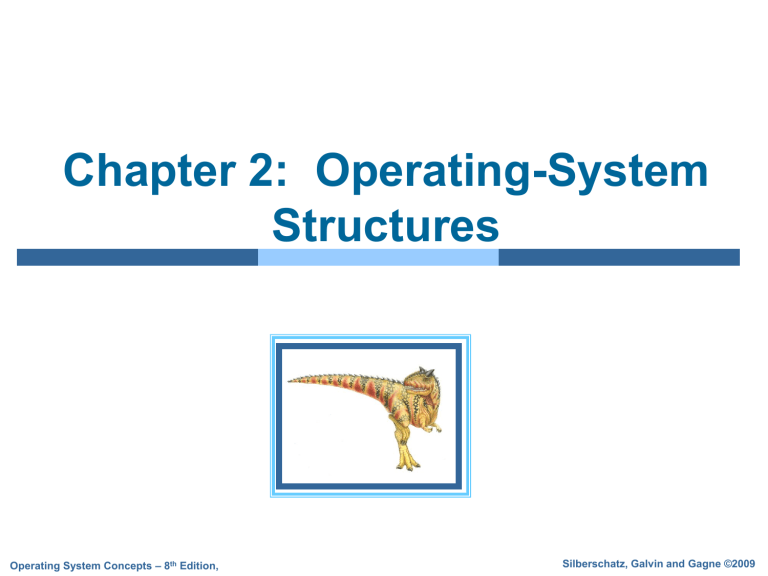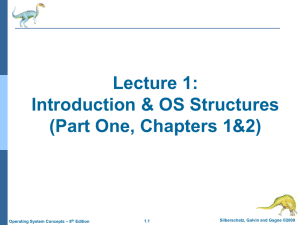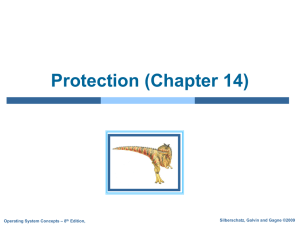
Chapter 2: Operating-System Structures Operating System Concepts – 8th Edition, Silberschatz, Galvin and Gagne ©2009 Chapter 2: Operating-System Structures Operating System Services User Operating System Interface System Calls Types of System Calls System Programs Operating System Design and Implementation Operating System Structure Operating System Debugging Operating System Generation System Boot Operating System Concepts – 8th Edition 2.2 Silberschatz, Galvin and Gagne ©2009 Objectives To describe the services an operating system provides to users, processes, and other systems To discuss the various ways of structuring an operating system To explain how operating systems are installed and customized and how they boot Operating System Concepts – 8th Edition 2.3 Silberschatz, Galvin and Gagne ©2009 Operating System Services One set of operating-system services provides functions that are helpful to the user: User interface - Almost all operating systems have a user interface (UI) Varies between Command-Line (CLI), Graphics User Interface (GUI), Batch Program execution - The system must be able to load a program into memory and to run that program, end execution, either normally or abnormally (indicating error) I/O operations - A running program may require I/O, which may involve a file or an I/O device File-system manipulation - The file system is of particular interest. Obviously, programs need to read and write files and directories, create and delete them, search them, list file Information, permission management. Operating System Concepts – 8th Edition 2.4 Silberschatz, Galvin and Gagne ©2009 A View of Operating System Services Operating System Concepts – 8th Edition 2.5 Silberschatz, Galvin and Gagne ©2009 Operating System Services (Cont) One set of operating-system services provides functions that are helpful to the user (Cont): Communications – Processes may exchange information, on the same computer or between computers over a network Communications may be via shared memory or through message passing (packets moved by the OS) Error detection – OS needs to be constantly aware of possible errors May occur in the CPU and memory hardware, in I/O devices, in user program For each type of error, OS should take the appropriate action to ensure correct and consistent computing Debugging facilities can greatly enhance the user’s and programmer’s abilities to efficiently use the system Operating System Concepts – 8th Edition 2.6 Silberschatz, Galvin and Gagne ©2009 Operating System Services (Cont) Another set of OS functions exists for ensuring the efficient operation of the system itself via resource sharing Resource allocation - When multiple users or multiple jobs running concurrently, resources must be allocated to each of them Many types of resources - Some (such as CPU cycles, main memory, and file storage) may have special allocation code, others (such as I/O devices) may have general request and release code Accounting - To keep track of which users use how much and what kinds of computer resources Protection and security - The owners of information stored in a multiuser or networked computer system may want to control use of that information, concurrent processes should not interfere with each other Protection involves ensuring that all access to system resources is controlled Security of the system from outsiders requires user authentication, extends to defending external I/O devices from invalid access attempts If a system is to be protected and secure, precautions must be instituted throughout it. A chain is only as strong as its weakest link. Operating System Concepts – 8th Edition 2.7 Silberschatz, Galvin and Gagne ©2009 User Operating System Interface - CLI Command Line Interface (CLI) or command interpreter allows direct command entry Sometimes implemented in kernel, sometimes by systems program Sometimes multiple flavors implemented – shells Primarily fetches a command from user and executes it – Sometimes commands built-in, sometimes just names of programs » If the latter, adding new features doesn’t require shell modification Operating System Concepts – 8th Edition 2.8 Silberschatz, Galvin and Gagne ©2009 User Operating System Interface - GUI User-friendly desktop metaphor interface Usually mouse, keyboard, and monitor Icons represent files, programs, actions, etc Various mouse buttons over objects in the interface cause various actions (provide information, options, execute function, open directory (known as a folder) Many systems now include both CLI and GUI interfaces Microsoft Windows is GUI with CLI “command” shell Apple Mac OS X as “Aqua” GUI interface with UNIX kernel underneath and shells available Operating System Concepts – 8th Edition 2.9 Silberschatz, Galvin and Gagne ©2009 System Calls Programming interface to the services provided by the OS Typically written in a high-level language (C or C++) Mostly accessed by programs via a high-level Application Program Interface (API) rather than direct system call use Three most common APIs are Win32 API for Windows, POSIX API for POSIX-based systems (including virtually all versions of UNIX, Linux, and Mac OS X), and Java API for the Java virtual machine (JVM) Operating System Concepts – 8th Edition 2.10 Silberschatz, Galvin and Gagne ©2009 Example of System Calls System call sequence to copy the contents of one file to another file Operating System Concepts – 8th Edition 2.11 Silberschatz, Galvin and Gagne ©2009 System Call Implementation Typically, a number associated with each system call System-call interface maintains a table indexed according to these numbers The system call interface invokes intended system call in OS kernel and returns status of the system call and any return values The caller need know nothing about how the system call is implemented Just needs to obey API and understand what OS will do as a result call Most details of OS interface hidden from programmer by API Managed by run-time support library (set of functions built into libraries included with compiler) Operating System Concepts – 8th Edition 2.12 Silberschatz, Galvin and Gagne ©2009 API – System Call – OS Relationship Operating System Concepts – 8th Edition 2.13 Silberschatz, Galvin and Gagne ©2009 System Call Parameter Passing Often, more information is required than simply identity of desired system call Exact type and amount of information vary according to OS and call Three general methods used to pass parameters to the OS Simplest: pass the parameters in registers In some cases, may be more parameters than registers Parameters stored in a block, or table, in memory, and address of block passed as a parameter in a register This approach taken by Linux and Solaris Parameters placed, or pushed, onto the stack by the program and popped off the stack by the operating system Block and stack methods do not limit the number or length of parameters being passed Operating System Concepts – 8th Edition 2.14 Silberschatz, Galvin and Gagne ©2009 Types of System Calls Process control File management Device management Information maintenance Communications Protection Operating System Concepts – 8th Edition 2.15 Silberschatz, Galvin and Gagne ©2009 MS-DOS execution (a) At system startup (b) running a program Operating System Concepts – 8th Edition 2.16 Silberschatz, Galvin and Gagne ©2009 System Programs System programs provide a convenient environment for program development and execution. The can be divided into: File manipulation Status information File modification Programming language support Program loading and execution Communications Application programs Most users’ view of the operation system is defined by system programs, not the actual system calls Operating System Concepts – 8th Edition 2.17 Silberschatz, Galvin and Gagne ©2009 System Programs Provide a convenient environment for program development and execution Some of them are simply user interfaces to system calls; others are considerably more complex File management - Create, delete, copy, rename, print, dump, list, and generally manipulate files and directories Status information Some ask the system for info - date, time, amount of available memory, disk space, number of users Others provide detailed performance, logging, and debugging information Typically, these programs format and print the output to the terminal or other output devices Some systems implement a registry - used to store and retrieve configuration information Operating System Concepts – 8th Edition 2.18 Silberschatz, Galvin and Gagne ©2009 System Programs (cont’d) File modification Text editors to create and modify files Special commands to search contents of files or perform transformations of the text Programming-language support - Compilers, assemblers, debuggers and interpreters sometimes provided Program loading and execution- Absolute loaders, relocatable loaders, linkage editors, and overlay-loaders, debugging systems for higher-level and machine language Communications - Provide the mechanism for creating virtual connections among processes, users, and computer systems Allow users to send messages to one another’s screens, browse web pages, send electronic-mail messages, log in remotely, transfer files from one machine to another Operating System Concepts – 8th Edition 2.19 Silberschatz, Galvin and Gagne ©2009 Operating System Design and Implementation Design and Implementation of OS not “solvable”, but some approaches have proven successful Internal structure of different Operating Systems can vary widely Start by defining goals and specifications Affected by choice of hardware, type of system User goals and System goals User goals – operating system should be convenient to use, easy to learn, reliable, safe, and fast System goals – operating system should be easy to design, implement, and maintain, as well as flexible, reliable, error-free, and efficient Operating System Concepts – 8th Edition 2.20 Silberschatz, Galvin and Gagne ©2009 Operating System Design and Implementation (Cont) Important principle to separate Policy: What will be done? Mechanism: How to do it? Mechanisms determine how to do something, policies decide what will be done The separation of policy from mechanism is a very important principle, it allows maximum flexibility if policy decisions are to be changed later Operating System Concepts – 8th Edition 2.21 Silberschatz, Galvin and Gagne ©2009 Operating-System Debugging Debugging is finding and fixing errors, or bugs OSes generate log files containing error information Failure of an application can generate core dump file capturing memory of the process Operating system failure can generate crash dump file containing kernel memory Beyond crashes, performance tuning can optimize system performance Kernighan’s Law: “Debugging is twice as hard as writing the code in the first place. Therefore, if you write the code as cleverly as possible, you are, by definition, not smart enough to debug it.” DTrace tool in Solaris, FreeBSD, Mac OS X allows live instrumentation on production systems Probes fire when code is executed, capturing state data and sending it to consumers of those probes Operating System Concepts – 8th Edition 2.22 Silberschatz, Galvin and Gagne ©2009 Operating System Generation Operating systems are designed to run on any of a class of machines; the system must be configured for each specific computer site SYSGEN program obtains information concerning the specific configuration of the hardware system Booting – starting a computer by loading the kernel Bootstrap program – code stored in ROM that is able to locate the kernel, load it into memory, and start its execution Operating System Concepts – 8th Edition 2.23 Silberschatz, Galvin and Gagne ©2009 System Boot Operating system must be made available to hardware so hardware can start it Small piece of code – bootstrap loader, locates the kernel, loads it into memory, and starts it Sometimes two-step process where boot block at fixed location loads bootstrap loader When power initialized on system, execution starts at a fixed memory location Firmware used to hold initial boot code Operating System Concepts – 8th Edition 2.24 Silberschatz, Galvin and Gagne ©2009


